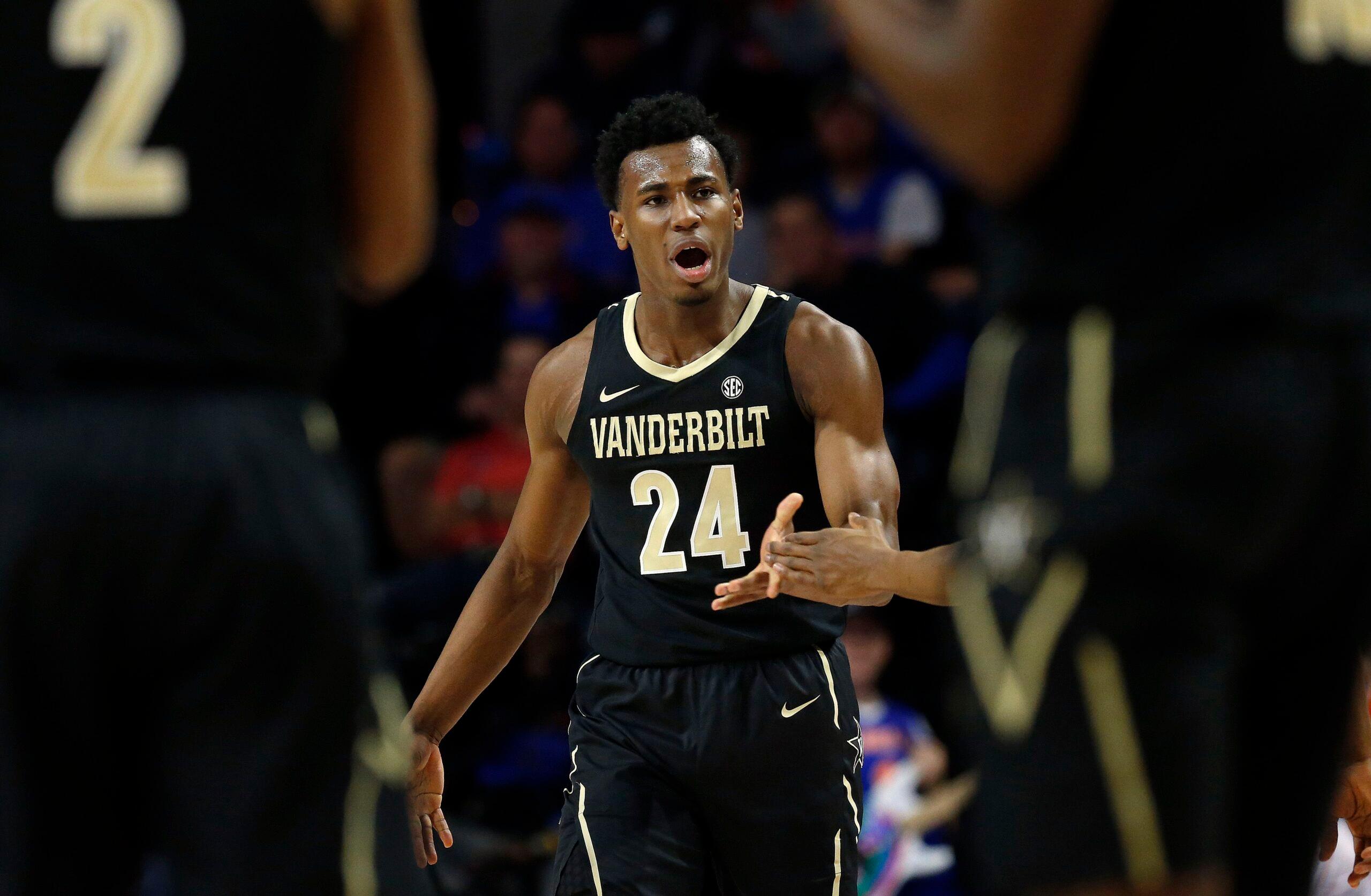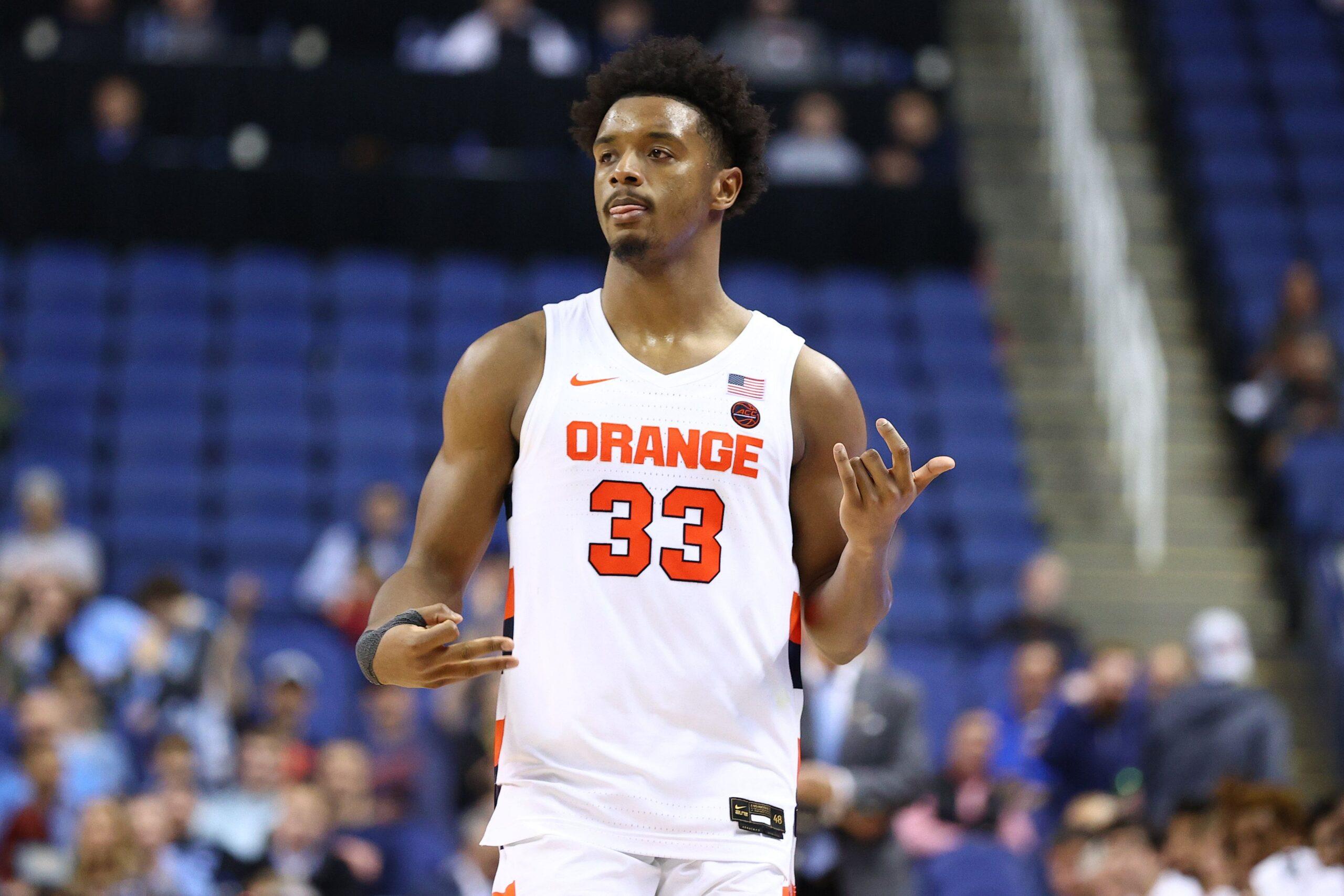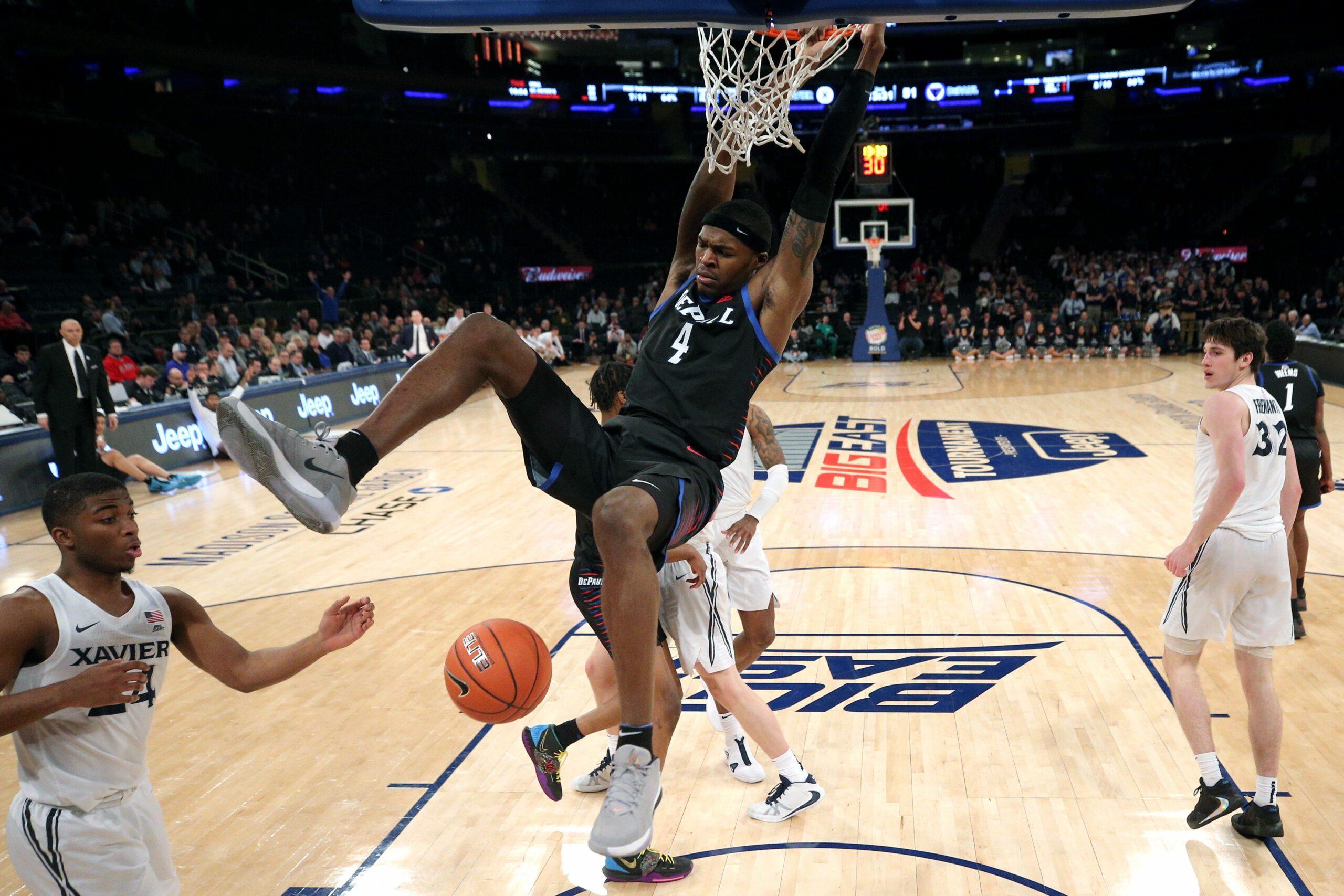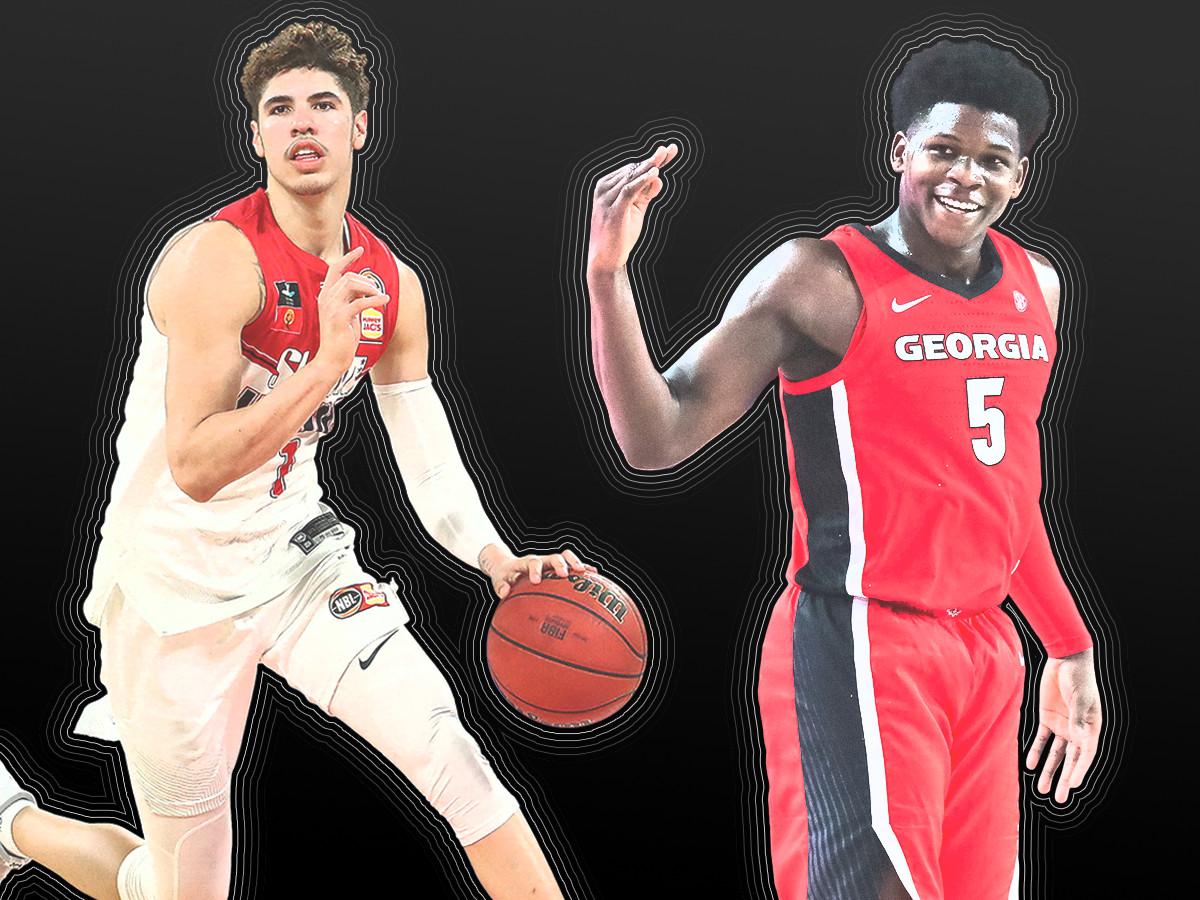The voice on the other side of the computer made Syracuse’s Elijah Hughes do a double-take. “What is your favorite toe?”
Hughes was in the middle of one of the 20-plus Zoom interviews he’s done with NBA teams from his home in upstate New York ahead of November’s draft. Most questions up to that point had been conventional. This one was not.
“Someone asked me that,” says Hughes, a projected second-round pick. “Like, your middle toe, your big toe … it was weird.”
Each draft season, prospects are bombarded with questions both bland and peculiar. DePaul’s Paul Reed says he was thrown off when a team staffer asked him what his mom would say was his biggest weakness. This year, the entire process has been peculiar, with questions being asked virtually, and players and teams talking hundreds, sometimes thousands, of miles apart.
As the pandemic has put the NBA on a roller coaster schedule, draft prospects have been waiting. Waiting for a gym to open. Waiting for a combine that won’t happen. Waiting for a workout, an interview. Waiting for a draft date that kept getting pushed back.
In September, the draft was finally set for November 18—roughly five months after the original date. During those five months, the usual beats of the predraft process have either been removed or recast to fit in this new reality. Recently, teams have been meeting players in person (each team gets 10 visits with limited contact), but without a combine, pro days, and even something as simple as conversations over dinner, it’s been a challenge for players to find their footing.
“There’s so much uncertainty,” says Reed, a projected late first-rounder. “It’s just been the waiting. I’ve been waiting since I was 4 years old.”
“It’s so different, it’s unprecedented … nothing’s guaranteed,” says Villanova’s Saddiq Bey, a projected top-20 pick. “I think [the toughest part] is the time. The draft was supposed to happen [on] June 25, originally, so the toughest part is being anxious. I just really want to play.”

In some ways, Aaron Nesmith has been preparing for a situation like this since he was 12 years old, when his humid summer South Carolina mornings would begin at 6 o’clock. He and his brother would go out in the woods to a piece of land their dad owned that he wanted cleared out. The job was to cut down trees and burn them for as long as the day lasted.
“He was just clearing [the land] out and he’s got two boys, two hands, so he thought, ‘A 10-to-12-year-old can go out there and help out.’ That’s what I did,” says Nesmith, a potential lottery pick. “My dad taught me, ‘If you don’t want to be doing this work every single day then make sure you work hard so that you don’t have to be outside and cutting down trees every single day.’”
Nesmith is no longer cutting down trees. Instead, he’s shooting 100 to 200 3s a day. But the work ethic he developed back then remains, and it’s helping him now during this long delay. When the college basketball season was canceled in March and his time at Vanderbilt was finished, Nesmith returned to his family’s home in Charleston and started waking up early again—this time at 6:40 a.m. He would go straight to the weight room and lift before doing a corrective workout (to improve body alignment and flexibility) and a basketball one too. The three-a-days have become routine, as has checking off a list of goals. These tasks have helped keep Nesmith engaged and on pace, even when he didn’t know when the draft would be.
“I have to be in the best shape that I possibly can. I got to be ready to go,” Nesmith says. “Going to a private school at a young age taught me time management real early. I learned that you got to make a schedule for your day, pretty much days in advance. I know what I’m doing tomorrow, today, pretty much just because I’m so time-oriented.”
Nesmith has been working out with trainer Travis Smith, who also counts fellow Charleston native Khris Middleton as a client. DePaul’s Reed worked out with a trainer who had a private gym in Orlando and turned a garage into a weight room early on during the pandemic. But not every prospect had the luxury of a trainer during quarantine, let alone a full gym.
Washington’s Isaiah Stewart, a projected late first-rounder, began the long layoff by doing the simplest workout he could: running. A couple of miles each morning plus lifting a few old weights his dad had in the garage in upstate New York were enough to keep Stewart going. His brother, who majored in culinary arts, cooked his meals to manage his nutrition, and from afar his agent sent workouts and other necessary equipment. Stewart eventually got a trainer, USA Nike Hoop Summit coach Scott Fitch, and began working out with him at 8 a.m. as gyms started opening up. The workouts have focused on Stewart’s shooting, and he and Fitch debrief daily on his progress.
“It’s a long process, a lot of uncertainty, a lot of guys could lose focus, but I just kept my focus the whole way and just been taking days off the calendar,” Stewart says. “I know one day, basketball is going to resume.”
For a while, though, it was unclear when basketball, or the draft, would resume. That lack of information required players to be self-starters, and there was no even playing field. As one Western Conference front office staffer pointed out, based on the interviews he’s been a part of, some players have been in workouts with multiple trainers and some players have been going to a gym with only a family member to rebound for them.
Some have had to be resourceful. Nesmith films all of his workouts and studies them. Stewart, a 6-foot-9 big man, has been studying Synergy film of Bam Adebayo and Montrezl Harrell when he’s not in the gym. After a day of workouts and finishing up online classes, Reed would return to the gym at night for shooting sessions. All of them watched the NBA games in Orlando, wishing they could also be playing and taking mental notes about adjusting to the pace of play once they do return to the court.
Bey has been working with a basketball trainer and a strength and conditioning trainer, but he has been bouncing around gyms in the DMV, from Maryland to D.C. He takes a dynamic approach, with basketball and lifting as the core tenets, and yoga and conditioning sessions peppered in between.
“With gyms and places being more open now, obviously it’s better, but I was always finding ways to be able to work out, stay ready, stay in shape,” Bey says. “I know this process is not normal as it used to be, but I still feel that I’ve been getting the right amount of work in.”

For a few months, no player knew what the right amount of work was. Without a firm date to aim for until mid-September, pacing was an inexact science. Hughes took a different approach than most. When the college basketball season ended, he returned home to upstate New York and took a month off—a mental break.
“That first month or two was kind of just a relaxed period to just get my mind and body back,” Hughes says. “Being a college athlete and playing basketball, it’s really hard to get time to come home. So I just took advantage of that quality time I could give my sisters and my parents.”
Hughes says he emerged from the break refreshed. He started working with a trainer in Schenectady, and later moved there. Most of the players I spoke to say that the extended time off benefited both their bodies and their games. “I’m even more prepared than I would have been if I went [into the NBA] four or five months ago,” Nesmith says.
“My life has been boring throughout this process; all I’ve been really focusing on is basketball,” Stewart says. “Even when I’m not working out, [I’m] thinking about it and talking about it. … I just feel like this long process has allowed me to get better and work on my game even more.”
Reed began his two-or-three-a-day workouts in Orlando almost immediately after leaving school, but his early pace soon took a toll on his body, so he slowed down at the behest of his trainers and agent. He’s now in Chicago, where he’s established a more balanced routine. He says that he’s learned proper pacing and recovery during the time off, along with self-reflection.

“It’s almost like an extra offseason,” Reed says. In between hanging out with his girlfriend and taking his sisters for ice cream trips in Orlando, he started reading self-help books too. “It gave me more growth. I probably wouldn’t be able to grow as much as I did as a person and as a basketball player without this.”
Hughes can see the connection between individual workouts and improvement, but notes there’s a potential downside too. “Anytime you give somebody more time to work on something, they’re going to be better at it,” Hughes says. “But you know, I’m kind of itchy right now. I’m antsy, and I’ve been antsy for the last two months now. I’m just ready to get going.”
One of the toughest parts of this time for agents of these prospects has been keeping them engaged and optimistic. It hasn’t been easy. One agent had a client go back to school instead of wait out the process, while another player took an offer overseas a few months ago to make money sooner.
“You have a kid who thinks his life is gonna change in July, and then it gets pushed back over and over,” one agent says. “If I was him I would be saying, ‘You gotta be kidding me. I’ve worked my whole life for this, and this is the longest process.’”
But the wait, for those who have stuck with it, has also been fruitful. Markus Howard, who is projected as a late second-rounder, says the process has been “tedious” but rewarding. He was a phenom in college, a 5-foot-11 scoring machine with a 50-point game and a pair of 40-pointers last season as a senior. He’s confident that the extra work he’s put in has made him a better player, the next small guard to surprise the league.
“There’s a lot of uncertainty about when things are going to happen. That’s been the toughest thing,” Howard says. “I’ve been fortunate. … We’ve had a fixed schedule from the time I came back and have followed it since. To have that has been great.”
Howard’s setup is familiar to him, in multiple ways. He’s working with his dad and his brother at a facility in Arizona, going from around 5 a.m. to 9 a.m. every day and then napping, reading books, playing video games and cards the rest of the day. Having two people to work with has been a boon.
Prospects have mostly been working one-on-one with a trainer, rarely getting a chance to go five-on-five or competing alongside other players. Florida State’s Patrick Williams, a potential lottery pick, says he’s been playing five-on-five only once a month. “COVID is nothing to play around with,” he says. “You miss going against guys. But when we are in the gym, we compete. As long as I’m competing, I’m good.”
This has been a dilemma for teams too. While they try to glean what they can from 25-minute Zoom interviews and the copious amounts of intel they’ve gathered, the long delay has introduced a mystery factor. Teams don’t really know how a player may have changed during the past six months, and it doesn’t help that evaluators haven’t been able to compare them against any kind of competition, especially other prospects.
One front office staffer says the ability prospects have shown to manage their development outside the traditional college system only bolsters the case for the path that Jalen Green and other top 2021 draft prospects took, skipping the NCAA and signing on to play for a G League team to focus on development. Provided the G League Ignite experiment affords these players with everything the league says it will—veteran teammates, competitive opponents—a case can be made, the staffer says, that those on the G League Ignite team are in a better situation than current and future college prospects. The latter don’t even have a start date for their season yet. “The whole objective is strictly focused on NBA development,” the front office staffer says. “So, I’d say they’re in a better environment than nearly all colleges right now.”
The uncertainty for some prospects likely won’t end on draft night. With no summer league (or winter league) expected to be held between November 18 and the start of the season (likely in late December or late January), undrafted players won’t have the typical opportunities to make their case for a roster spot. “I’m not going to not be antsy now,” Hughes says. “After the draft I’m going to be antsy. I’m going to be antsy the rest of my life, so I don’t know. That’s how I am.”
In some ways, the stunted predraft process leaves less room for intangibles to factor in. One college coach says the obstacles brought on by the pandemic—the cold remote interviews, the lack of workouts and pro days—will affect prospects who could have made leaps just by performing or speaking to teams in person.
On the other hand, some believe that this process helps the hidden gems in this year’s draft and exposes the flaws of higher-ranked prospects. With so much time to go over film and scouting reports, there’s next to no one and nothing that these teams haven’t already looked at. One member of a front office says that their whole scouting department has a strong opinion about nearly everyone in the draft. In the past, the time crunch would not have allowed for that.
“I think there are going to be less clear misses,” the staffer says. “I think that just with all the time to prepare, you’re no longer maybe going off of one or two scouts feeling strongly about a player because everyone in the scouting group has seen everybody. So I think it’s going to be more of a well-educated draft. There’s still going to be mess-ups, but I think that’s going to be less common.”
Others theorize that teams might be more inclined to go after sure things, take fewer risks, and save their bolder decisions for future drafts. That effect could trickle down from the top of the draft, through the lottery, and all the way to the end of the second round. Even those who are signed as undrafted free agents will have it tougher than other players in their position did in previous years. Rosters could expand this season to account for possible COVID-related absences, just like the league did in Orlando, but teams may lean on players who can provide a more immediate impact for those slots.
“We’re going to see which guys are really ready to contribute,” the college coach says. “They don’t have the whole summer to work with the team on things they need to work on and understanding concepts, so we’re really going to see who is able to come in and learn quickly and positively impact their teams. It’s going to be much more difficult than normal circumstances for this year’s rookie class.”
The players, meanwhile, can only wait and hope that what they’ve done—on game film, in limited workouts, and during interviews—is enough to get them selected on November 18. They won’t know just how this long, complicated predraft process has affected them until they hear their name or don’t. And even if they do get picked, there will be no walk-up, no handshake, and no photo op with Adam Silver. But after the long months of simply waiting and working, the end to this part of their abnormal journey might feel even more rewarding than it would in a normal year.
“You’ve kind of just got to deal with it,” Hughes says. “I can’t let a 22-year lifelong dream get affected by a couple long months, you know?”
